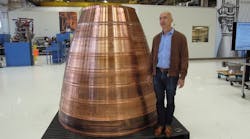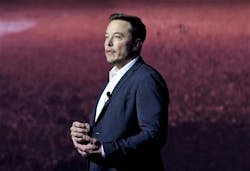In the past few weeks, two U.S. billionaires have presented their latest visions of extending human civilization into the Solar System. It is an old idea, but on the surface Jeff Bezos and Elon Musk appear to have the ambition, funds and sheer chutzpah to at least get the ball rolling. Both have space vehicles flying, skilled engineering staffs and businesses unrelated to spaceflight that can subsidize their lofty enthusiasms. But the ways they are tackling the problem could not be more different.
At the International Astronautical Congress (IAC) in Guadalajara, Mexico, both approaches were on view Sept. 27, the second day of the annual gathering of space experts from around the world. In the morning Rob Meyerson, who runs Blue Origin for Bezos, gave a half-hour presentation on his company’s work on the suborbital New Shepard vehicle that has now flown to the edge of space five times with the same engine.
He also took questions, which led to a pretty good description of what Blue Origin hopes to do with the “New Armstrong” launch vehicle Bezos unveiled last month as a successor to the “New Glenn” orbital launcher now on the drawing board.
“When we have millions of people living and working in space we want them to be able to go to lots of destinations, and Mars would be one of them; the Moon would be another,” Meyerson says. “So New Armstrong is going to be designed to support that long-term vision, and this is a vision that is going to take decades to achieve.”
Like his boss at an earlier appearance in Long Beach, California, Meyerson would not reveal the planned payload capacity for New Glenn, which is being designed to generate 3.8 million lb. thrust at liftoff using seven of the company’s new BE-4 engines. Both men promised to disclose more about the orbital launcher next year.
That follows the Blue Origin practice of dribbling out information about its work in carefully scripted—and controlled—morsels. After the successful ascent-abort test of New Shepard on Oct. 5, Blue Origin blocked an Aviation Week interview request with Aerojet Rocketdyne, which manufactured the 70,000-lb.-thrust solid-fuel motor that blasted the human-rated capsule away from its liquid-fueled booster.
Bezos did tweet a response after the New Shepard booster withstood the capsule-ejection forces, throttled down to handle aerodynamic loads without the conical capsule on top, and proceeded through its normal flight profile to a spectacular tail-down landing. “That is one hell of a booster,” was his succinct summation.
Musk, by contrast, staged the space-geek equivalent of a rock concert at the IAC the afternoon of Meyerson’s measured performance. His audience started gathering at the doors to the 3,000-seat auditorium hours ahead of time, drawn by months of tantalizing tweets from the SpaceX founder about revealing his plan to build a self-sustaining civilization on Mars. Even so, his staff didn’t swing open the doors until after the appointed hour, guaranteeing a dangerous stampede that got the adrenaline flowing for the razzle-dazzle presentation to come.
Where Meyerson presented some spectacular videos of past New Shepard flights—in keeping with Bezos’s stated policy of talking about what he has accomplished instead of what he is going to do—Musk displayed slick animations of a huge spaceship he says will take colonists to Mars 100 at a time for $100,000 a head, starting sometime before 2030 (AW&ST Oct. 10-23, p. 34).
One businessman who witnessed the performance said it reminded him of a pitch for venture capital on Silicon Valley’s Sand Hill Road, long on promises but short on real answers. In a chaotic question-and-answer session with audience members, Musk dodged technical issues such as surface-power sources and life-support systems. Later, at a hastily called press conference after the public session, he suggested “entrepreneurial energy” would deal with those issues when the time comes.
Compared to the Blue Origin approach, it is easy to scoff at Musk’s stagy performance, and there were plenty of knowledgeable adults at the IAC who were ready to do so—off the record. But the fact remains that SpaceX is far ahead of Blue Origin in actual accomplishments.
The company has orbited satellites and sent cargo to the International Space Station (ISS), recovering first stages of its Falcon 9 launcher on land and at sea. It is working with real astronauts to qualify a version of its Dragon capsule for human spaceflight to deliver crews to the ISS, under a $2.6 billion NASA contract.
Still, there is a dark side to the SpaceX scenario. Faced with two mission-ending upper-stage explosions of the Falcon 9, the most recent during preflight checkout, the company has gone so far as to suggest sabotage by competitor United Launch Alliance (ULA) as the cause. Unfortunately, it is not the first time company operatives have resorted to rumormongering to advance the SpaceX cause, approaching reporters with innuendos about personnel changes at ULA—implications that appear to have no merit.
After the ascent-abort test Bezos tweeted a photo of his cowboy boots emblazoned with Blue Origin’s Latin motto “Gradatim Ferociter”—step by step, ferociously. In the brave new world of 21st-century robber barons, his approach makes more sense to this old-fashioned reporter.
This content was originally published on Aviation Week. Aviation Week is, like IndustryWeek, powered by Penton, an information services company.




